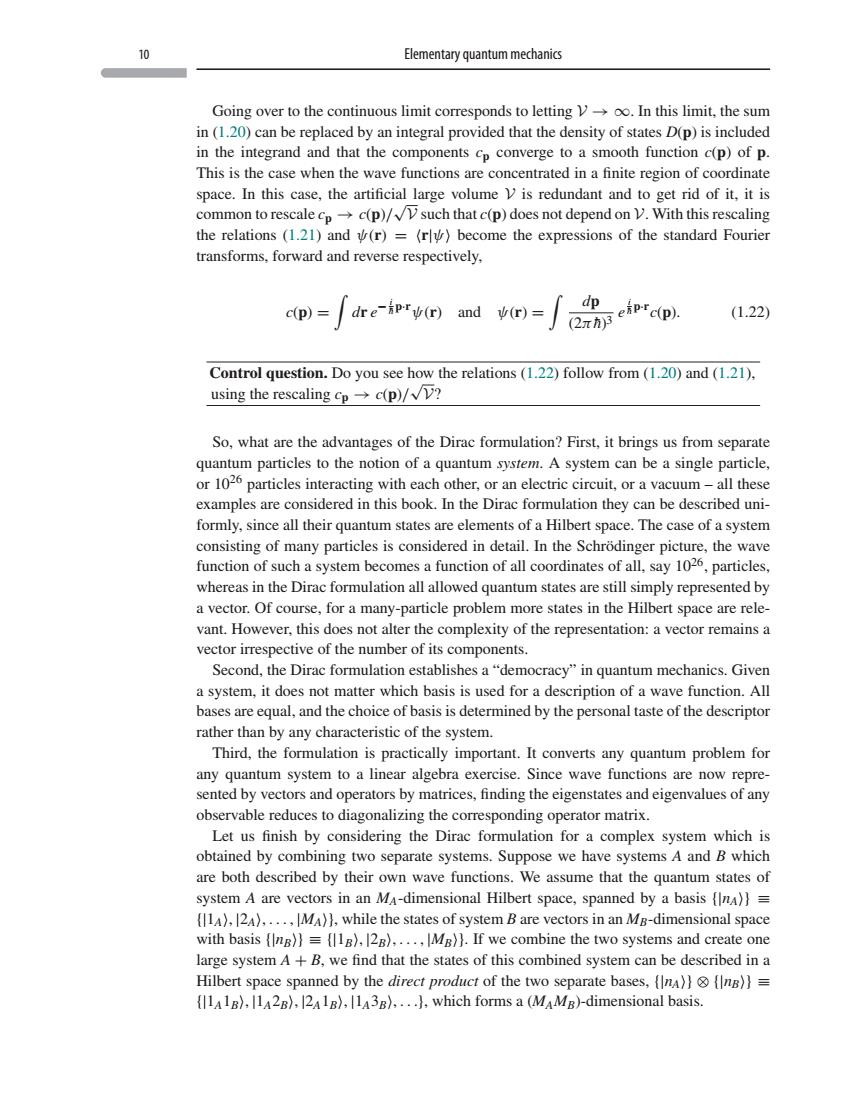正在加载图片...

Elementary quantum mechanics Going over to the continuous limit corresponds to letting oo.In this limit,the sum in(1.20)can be replaced by an integral provided that the density of states D(p)is included in the integrand and that the toas c(p)of p space.In this case,the artificial large volume y is redundant and to get rid of it,it is common to rescale cpc(p)/such that c(p)does not depend on V.With this rescaling the relations(1.21)and(r)=(r)become the expressions of the standard Fourier transforms.forward and reverse respectively p=∫de)and=∫a2 dp (1.22) Control question.Do you see how the relations(1.22)follow from(120)and(121). using the rescaling cpc(p)/V? So,what are the advantages of the Dirac formulation?First,it brings us from separate quantum particles to the notion of a quantum system.A system can be a single particle acting with each other,or an electric circuit,or a vacuun all thes examples are considered in this book.In the Dirac formulation they can be described uni formly,since all their quantum states are elements of a Hilbert space.The case of a system consisting of many particles is considered in detail.In the Schrodinger picture,the wave function of such a system becomes a function of all coordinates of all,say 1026,particles, whereas in the Dirac formulation all allowed quantum states are still simply represented by a vector.Of cou fo ra many-particle problem n more states in the Hilb rt space are rele vant.However.this does not alter the complexity of the representation:a vector remains a vector irrespective of the number of its components. Second,the Dirac formulation establishes a"democracy"in quantum mechanics.Given tdoes not matte whch as ued tor deserpton of wav fungtion.Al equal,and the choice of basis is determined by the personal taste of the descriptor rather than by any characteristic of the system Third,the formulation is practically important.It converts any quantum problem for any quantum system to a linear algebra exercise.Since wave functions are now repre- sented by vectors and operators by matrices,finding the eigenstates and eigenvalues of any observable reduces to diagonalizing the corresponding operator matrix. considering the Dirac formulation f or complex x system which is ning two separate systems.Suppose we have systems A and B whic are both described by their own wave functions.We assume that the quantum states of system A are vectors in an Ma-dimensional Hilbert space,spanned by a basis (Ina)}= ()12)...IM)).while the states of system B are vectors in an MR-dimensional space with basis (n))=(1).12) .IMg)).If we combine the two systems and create on large systemA+B.we find that the states of this combined system can be described ina Hilbert space spanned by the direct product of the two separate bases,(InA))(ng))= (11A1g).11A2g),12A18).1A38)....).which forms a (MAMg)-dimensional basis.10 Elementary quantum mechanics Going over to the continuous limit corresponds to letting V → ∞. In this limit, the sum in (1.20) can be replaced by an integral provided that the density of states D(p) is included in the integrand and that the components cp converge to a smooth function c(p) of p. This is the case when the wave functions are concentrated in a finite region of coordinate space. In this case, the artificial large volume V is redundant and to get rid of it, it is common to rescale cp → c(p)/ √ V such that c(p) does not depend on V. With this rescaling the relations (1.21) and ψ(r) = r|ψ become the expressions of the standard Fourier transforms, forward and reverse respectively, c(p) = dr e − i h¯ p·r ψ(r) and ψ(r) = dp (2πh¯)3 e i h¯ p·r c(p). (1.22) Control question. Do you see how the relations (1.22) follow from (1.20) and (1.21), using the rescaling cp → c(p)/ √ V? So, what are the advantages of the Dirac formulation? First, it brings us from separate quantum particles to the notion of a quantum system. A system can be a single particle, or 1026 particles interacting with each other, or an electric circuit, or a vacuum – all these examples are considered in this book. In the Dirac formulation they can be described uniformly, since all their quantum states are elements of a Hilbert space. The case of a system consisting of many particles is considered in detail. In the Schrödinger picture, the wave function of such a system becomes a function of all coordinates of all, say 1026, particles, whereas in the Dirac formulation all allowed quantum states are still simply represented by a vector. Of course, for a many-particle problem more states in the Hilbert space are relevant. However, this does not alter the complexity of the representation: a vector remains a vector irrespective of the number of its components. Second, the Dirac formulation establishes a “democracy” in quantum mechanics. Given a system, it does not matter which basis is used for a description of a wave function. All bases are equal, and the choice of basis is determined by the personal taste of the descriptor rather than by any characteristic of the system. Third, the formulation is practically important. It converts any quantum problem for any quantum system to a linear algebra exercise. Since wave functions are now represented by vectors and operators by matrices, finding the eigenstates and eigenvalues of any observable reduces to diagonalizing the corresponding operator matrix. Let us finish by considering the Dirac formulation for a complex system which is obtained by combining two separate systems. Suppose we have systems A and B which are both described by their own wave functions. We assume that the quantum states of system A are vectors in an MA-dimensional Hilbert space, spanned by a basis {|nA} ≡ {|1A, |2A, ... , |MA}, while the states of system B are vectors in an MB-dimensional space with basis {|nB} ≡ {|1B, |2B, ... , |MB}. If we combine the two systems and create one large system A + B, we find that the states of this combined system can be described in a Hilbert space spanned by the direct product of the two separate bases, {|nA} ⊗ {|nB} ≡ {|1A1B, |1A2B, |2A1B, |1A3B, ...}, which forms a (MAMB)-dimensional basis.��